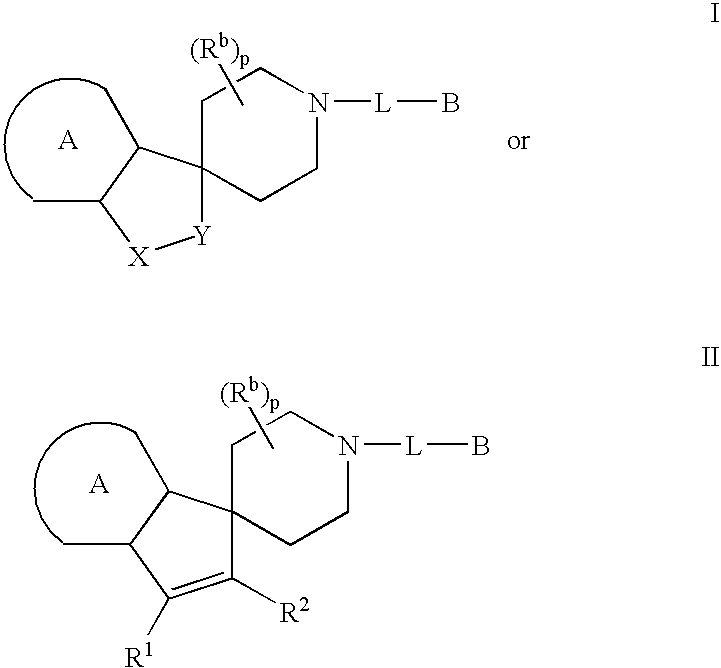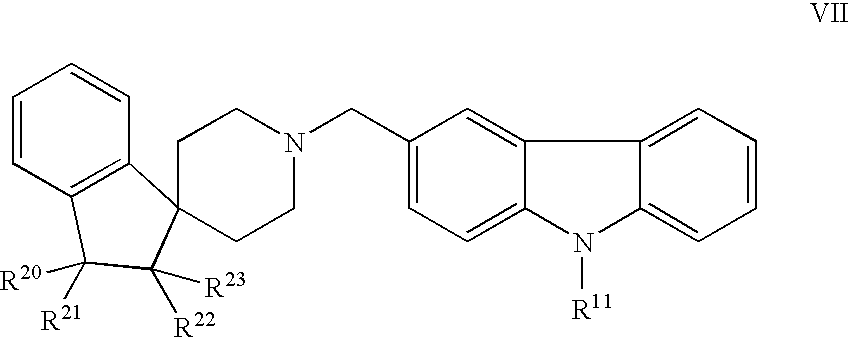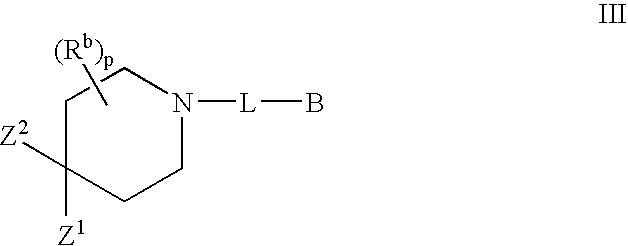Piperidine derivatives
a technology of piperidine and derivatives, applied in the field of piperidine derivatives, can solve the problems of obesity, medical abnormalities, respiratory difficulties, etc., and achieve the effects of stimulating feeding, and reducing the risk of cardiovascular diseas
- Summary
- Abstract
- Description
- Claims
- Application Information
AI Technical Summary
Benefits of technology
Problems solved by technology
Method used
Image
Examples
example 1
6.1. Example 1
[0176] 18
[0177] Step 1: A mixture of indene i (5.0 g, 17.5 mmol) and mCPBA (5.75 g, purity 77% max.) in CH.sub.2Cl.sub.2 was stirred for 3 h at room temperature. The reaction mixture was poured into aqueous NaHCO.sub.3 and extracted with EtOAc. The organic layer was separated, washed with brine, dried with anhydrous Na.sub.2SO.sub.4, concentrated by rotary evaporation and purified by flash chromatography on silica gel with a gradient elution of 20-40% EtOAc / hexanes to yield epoxide ii as a white solid (4.1 g).
[0178] Step 2: Epoxide ii (4.1 g, 13.6 mmol) was heated with HCO.sub.2NH.sub.4 (6.60 g, 104.7 mmol) and 10% Pd / C (0.88 g) in dioxane at 80.degree. C. for 1 h. The mixture was cooled to room temperature and filtered through a Celite pad. The filtrate was partitioned between EtOAc and water. The organic layer was separated, washed with brine, dried with anhydrous Na.sub.2SO.sub.4, concentrated by rotary evaporation and purified by flash chromatography on silica gel ...
example 2
6.2. Example 2
[0182] 19
[0183] Step 1: A mixture of epoxide ii (0.482 g, 1.6 mmol) and NaN.sub.3 (0.416 g, 6.4 mmol) in EtOH (8 mL) and DMSO (8 mL) was heated to 80.degree. C. for 30 min. The reaction mixture was cooled to room temperature, poured into aqueous NaHCO.sub.3 and extracted with EtOAc. The organic layer was separated, washed with brine, dried with anhydrous Na.sub.2SO.sub.4, concentrated by rotary evaporation and purified by flash chromatography on silica gel with a gradient elution of 30-40% EtOAc / hexanes to yield azide vi as a yellowish solid (0.145 g).
[0184] Step 2: Azide vi (0.100 g, 0.29 mmol) was stirred with PPh.sub.3 (0.152 g, 0.58 mmol) in THF (2 mL) under N.sub.2 at room temperature for 5 h. Water (0.20 mL) was added and the mixture was heated to 70.degree. C. for 4 h. The mixture was loaded directly on a silica gel column. Elution with a gradient of 20-30% MeOH--CH.sub.2Cl.sub.2 with 0-10% ammonium hydroxide to afforded amine vii as a white solid (0.071 g).
[018...
example 3
6.3. Example 3
[0187] 20
[0188] Step 1: A mixture of bis(2-chloroethyl)amine HCl (4.462 g, 25 mmol), benzyl aldehyde (2.6 mL, 30 mmol), NaBH(OAc).sub.3 and TEA (3.5 mL, 25 mmol) in 1,-2-dichloroethane (150 mL) was stirred at room temperature for 6 h. The reaction mixture was poured into aqueous NaHCO.sub.3 and extracted with EtOAc. The organic layer was separated, washed with brine, dried with anhydrous Na.sub.2SO.sub.4, concentrated by rotary evaporation and purified by flash chromatography on silica gel with a gradient elution of 10-40% EtOAc / hexanes to yield N-benzyl-N,N-di(2-chloroethyl)amine as a clear oil (4.48 g).
[0189] Step 2: To a mixture of KOtBu (37.6 mL, 37.6 mmol, 1M / tBuOH) in DMSO (80 mL) under N.sub.2 was added .beta.-tetralone (2.50 g, 17.1 mmol, in DMSO) dropwise followed by addition of N-benzyl-N,N-di(2-chloroethyl)a-mine (3.82 mL, 18.8 mmol). After stirring overnight at room temperature, the mixture was poured into water and extracted with EtOAc. The organic layer w...
PUM
| Property | Measurement | Unit |
|---|---|---|
| temperature | aaaaa | aaaaa |
| temperature | aaaaa | aaaaa |
| temperature | aaaaa | aaaaa |
Abstract
Description
Claims
Application Information
 Login to View More
Login to View More - R&D
- Intellectual Property
- Life Sciences
- Materials
- Tech Scout
- Unparalleled Data Quality
- Higher Quality Content
- 60% Fewer Hallucinations
Browse by: Latest US Patents, China's latest patents, Technical Efficacy Thesaurus, Application Domain, Technology Topic, Popular Technical Reports.
© 2025 PatSnap. All rights reserved.Legal|Privacy policy|Modern Slavery Act Transparency Statement|Sitemap|About US| Contact US: help@patsnap.com



